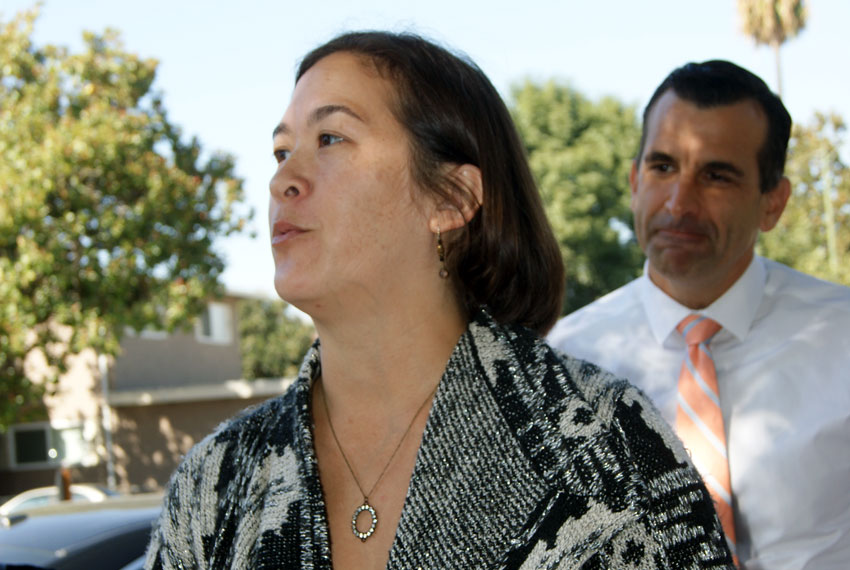San Jose Prepares for Disaster with Measure T
San Jose Mayor Sam Liccardo (c) with Minh Do, a resident (l), and Tam Nguyen, a city council man, at the Measure T media briefing in San Jose, Calif., Oct. 25. (Fernando Torres photo)
On a recent sunny afternoon at Rock Springs Park, San Jose Mayor Sam Liccardo, councilman Tam Nguyen and environmentalist Alice Kaufman met ethnic representatives to talk about Measure T, on the Nov. 6 ballot, writes Mark Hedin for Ethnic Media Services.
The measure would fund overdue upgrades to city infrastructure and allow land in neighboring Coyote Valley to be preserved from development, which would help avoid a repeat of last year’s disastrous flooding.
A parcel tax estimated at $60-$65 annually for the average San Jose home would provide $650 million to replace or upgrade earthquake-vulnerable bridges, firehouses and emergency shelters, rebuild the storm sewer system and enhance groundwater supplies by preserving open space.
Nguyen and some neighborhood residents recalled how Coyote Creek, running alongside the park entrance, had overflowed its banks during last year’s February rains, filling the streets and neighboring homes with mud before overwhelming a nearby pumping station, adding raw sewage to the mess.
Cleanup costs were estimated at $100 million.
For Measure T to pass, it will require a two-thirds majority of San Jose’s voters. The mayor emphasized that the funds are “capital restricted” – they cannot be used for salaries or pensions. The money either has to go to new infrastructure, repairs to old infrastructure or the acquisition of new property, such as the land in Coyote Valley.
Preserving Coyote Valley’s flood plain from development marks one of the first instances of putting “natural infrastructure” into a bond measure, according to Alice Kaufman, who works with Allinace for tk. Storing water naturally is “cheaper than building dams and bridges.” Allowing rainwater to percolate into the soil – and with strategic plantings to maximize water retention – will boost the underground aquifer and minimize added stress to the aging stormwater sewer system. Those 1,100 miles of pipleline and 32,000 storm drains, now 70 years old, are high on the list of infrastructure upgrades prioritized in Measure T planning.
“If we protect open space, it will protect us,” Kaufman told Ethnic Media Services.

Also on the Measure T list are a new fire station, pump station, emergency operations center, police training center and helicopter terminal. Plans to rehabilitate and improve existing property include possibly relocating two other fire stations, or at least fixing them up – the mayor said one is at risk of falling into a creek in an earthquake – along with various other fire stations and doing seismic retrofits on bridge overpasses.
The biggest single-ticket item on the list for Measure T is street repair – $300 million. Liccardo cited estimates that enough of the city’s streets are in poor repair that the average San Jose motorist currently racks up $700 annually in tire, extra gas and car maintenance costs.
The funds would pay for repairing the 388 miles of city streets, shown here(http://www.sanjoseca.gov/index.aspx?NID=4608), that rate poor, very poor or failed based on a scale known as the Pavement Condition Index.
The city has an unfunded need for capital replacement of $1.4 billion, Liccardo said.
Measure T has the endorsements of the entire city council, the police officers association, Sierra Club, League of Women Voters, the San Jose Mercury News and, in polling anyway, seems to have voters’ support. Whether that will translate into the two-thirds majority the laws require, remains to be seen.
But voter registration and turnout can’t be taken for granted, said Tam Nguyen, the District 7 city councilman who represents the Rock Springs neighborhood where the press conference was staged. With Minh Ngoc Do, he recalled months of work the neighborhood went through last year in cleaning up the homes, neighborhood and pump station after Coyote Creek overran its banks.
“It was like a war zone,” he recalled, “so heartbreaking.” People in the neighborhood – 90% of them Vietnamese or Spanish speaking – often live in crowded conditions, couch-surfing, staying in garage spaces and more, he said.
“We spent weeks cleaning up the mud and my friends lost everything,” local resident Do said. “We work very hard and we were devastated. The money from Measure T would bring many benefits and help keep us safe.”
As with most of the Measure T priorities, the cost of doing the maintenance and repair work is believed by advocates to be much less expensive than the ultimate costs of those systems’ failures in extreme weather or earthquakes.
Liccardo, looking back on the last time he’d been there, 20 months before, “a very trying time for thousands in the community devastated by a flood, we realized that there were lessons to be learned. Our failure to invest in flood and energy infrastructure, our residents paid the price for that.”
Measure T, he said, is “very straightforward raising money to prepare for disasters.”


